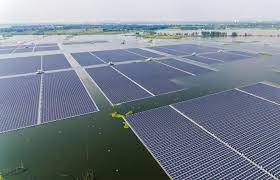Courtesy: dynamicslr.com
When it comes to addressing climate change, solar energy is one of the leading solutions, and it’s here to stay. Over the years, we have witnessed a growing surge in distributed PV solar systems installed on rooftops and solar farms to increase clean energy production. As research and development have continued in this sector, we now have floating solar panels.
What are floating solar panels? These are PV modules mounted on platforms that float on water reservoirs, lakes, and where conditions are right seas and oceans. However, these solar panels floating on water are more challenging and costly to construct. Let’s dive in and look at this technology in detail.
How Do Floating Solar Panels Work?

Floating solar is also known as photovoltaics or floating photovoltaic. It refers to any solar array that floats on top of a water body. Solar panels are affixed on buoyant structures, keeping them afloat on the water body surface. These floating solar panels are mostly found on lakes and dams as they are generally calmer than oceans.
Floating solar is an eco-friendly method of producing electricity. It combines marine and renewable energy technology. The electricity is sent from this floating body through underwater cables to a transmission tower.
Features of Floating Solar
A floating solar panel plant consists of the solar module, anti-rust material, vertical and horizontal frames, buoyancy body, inspection footrest, and module mount assembly. The solar module needs to be highly humidity resistant, dustproof, lead-free, and well protected from the effects of water. The buoyancy is made from polyethylene that can hold 2.5 times the weight. The floating structure is made from magnesium alloy coating, which is highly resistant to corrosion.
Advantages of Floating Solar
Below are some of the advantages of installing floating solar.
1. You Do Not Lose Valuable Land Space
Many ground-mounted solar panels result in the loss of valuable land space. However, with floating photovoltaics, you do not require land space. These installations can happen on unused space on water bodies such as wastewater treatment plants, drinking water reservoirs, or hydroelectric dam reservoirs. As a result, you can make use of land that you would have otherwise used to mount up solar panels. Additionally, installing solar panels on water bodies eliminates the need for deforestation.
2. Benefits the Environment
Floating solar panels are good for the environment. Water offers a colling effect for the PV modules. However, they also reduce evaporation from these water bodies, crucial in areas susceptible to droughts.
Additionally, having the solar panels floating on the water reduces algae blooms in freshwater bodies. Algae bloom can cause health complications when they appear in drinking water sources. They can also lead to the death of animals and plants in the water bodies.
Floating solar panels generate clean energy. Using renewable energy helps reduce dependence on fossil fuels’ generated electricity. As a result, there is a reduction in greenhouse gas emissions.
3. Improved Solar Performance
Though solar panels can perform well under high temperatures, their efficiency can reduce over time. As temperatures increase, their efficiency also drops. When you install PV modules on water bodies, the water provides a cooling effect which improves their efficiency.
Disadvantages of Floating Solar
There are two sides to each story, and below are some of the disadvantages of floating solar.
1. Expensive to Install
You require more money to install floating solar panels than a traditional PV system. One of the main reasons is because the technology is relatively new, thus requires specialized knowledge and equipment. However, as the technology advances, its installations costs are also expected to drop.
2. Limited Application
This technology does not just work for anyone. Many floating solar installations are large-scale, and they provide electricity to large communities, companies, or utility companies. If you want solar, choosing rooftop installation or ground-mounted solar is more practical.
Top 10 Floating Solar Farms by Capacity
| Floating Solar Farm | Capacity | Location |
| Saemangeum floating solar energy project | 2.1GW | Yellow Sea, Saemangeum, South Korea |
| Omkareshwar Dam floating solar farm | 600MW | Narmada river in Khandwa district of Madhya Pradesh, India |
| Hangzhou Fengling Electricity Science Technology’s solar farm | 320MW | Cixi, Zhejiang Province, China |
| Three Gorges New Energy’s floating solar farm | 150MW | Huainan City, Anhui Province, China |
| Cirata Reservoir floating photovoltaic (PV) power project | 145MW | West Java province, United Arab Emirates |
| NTPC Kayamkulam solar project | 105MW | RGCCPP Kayamkulam, Kerala, India |
| NTPC Ramagundam solar power plant | 100MW | Peddapalli district, Telangana, India |
| CECEP’s floating solar project | 70MW | Bengbu, in the province of Anhui, China |
| Sembcorp’s Tuas floating solar project | 60MW | Tengeh Reservoir in Tuas, South Korea |
| Hapcheon Dam floating PV power plant | 41MW | South Gyeongsang Province, South Korea |




Itís difficult to find experienced people for this topic, however, you sound like you know what youíre talking about! Thanks